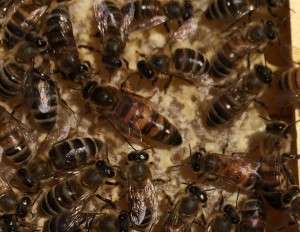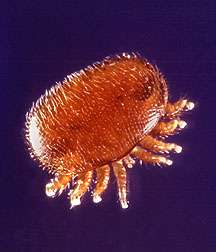Wisconsin State Bee Inspector Tests Sweet Mountain Farm Honeybees
September 24, 2015, Sweet Mountain Farm had visitors. Wisconsin State Bee Inspector Dan Ziehli from the Department of Agriculture Trade and Consumer Protection came to check out the Sweet Mountain Farm bee yard along with our invited guests from Brown County Beekeepers Association. Dan called me several weeks in advance to see if I would be interested in taking part in a colony study. He was sampling for exotic pests. It is a preventative check, proactively looking for pests that may pose future problems for Wisconsin beekeepers.
Eight bee yards from across the State of Wisconsin were selected. I gladly accepted the opportunity to participate in the study hoping to prove the benefits from locating an apiary in a seemingly protected Island location. I’ll report the lab results when it arrives but I would like to discuss the Varroa test results which were available immediately. What do you think is an acceptable level for Varroa? According to Dan, the State of Wisconsin says that 5 mites per 100 bees are considered Varroa free.
 Let’s begin by using Sweet Mountain Farm as a case study. The apiary began six years ago and has always been chemical free. The annual losses have been 12-20% averaging about 14% without the outlier year 2013/14 when the polar vortex froze out 73% of colonies. Do you think that a mite count would be higher in a chemical free environment? You might conclude that it is an Island location that keeps the colony losses low. Some might think that it is the bee itself that is tougher than most. Many astute beekeepers may speculate a combination of several factors that works together to improve overwintering results.
Let’s begin by using Sweet Mountain Farm as a case study. The apiary began six years ago and has always been chemical free. The annual losses have been 12-20% averaging about 14% without the outlier year 2013/14 when the polar vortex froze out 73% of colonies. Do you think that a mite count would be higher in a chemical free environment? You might conclude that it is an Island location that keeps the colony losses low. Some might think that it is the bee itself that is tougher than most. Many astute beekeepers may speculate a combination of several factors that works together to improve overwintering results.
All honeybees are not alike. Each breed has its own characteristics that need to be paired with a beekeepers management style, expectations and environment. USDA research on Russian honeybees was thoroughly examined before deciding to raise this genetically mite resistant stock. The Russian bee looks promising on several fronts.
The most significant data defining the Russian bee’s characteristics is its mite resistance, resource driven brood rearing, hygienic behavior, and cold hardiness. Research conducted by the USDA Honeybee Breeding Genetics and Physiology Laboratory in Baton Rouge, Louisiana cites multi-level evidence for Varroa resistant traits. For instance:
- Pupae emit a protein under stress when Varroa or Foulbrood is present. The workers smell the protein and clean out the cell.
- Hygienic behavior removes mites during grooming.
- In multiple timed freeze killed brood tests Russians clean out the cells faster than other species.
- Insignificant presence of tracheal mites and lower populations of hive beetle are reported.
- Queen egg laying is tied to ample pollen and nectar flows, shutting down production during periods of dearth. This shortens the time that brood is being reared. A shorter brood rearing time translates into fewer mites.
- Brood production does not start in the spring until there is an ample supply of pollen and nectar present preserving spring resources and helping to prevent spring starvation.
- The Russian colony size coming out of winter has fewer mouths to feed. The cluster is the size of a softball when most species are the size of a basketball. The smaller cluster size preserves food stores.

Sweet Mountain Farm further enhances its war on Varroa by using On the Spot queen rearing to split and re-queen colonies and hives have screened bottom boards. There may be additional viral or bacterial resistance that has not yet been tested.
Given all the evidence that suggests mite resistance, combined with a seemingly protected environment, I still saw Varroa on the bottom boards a few weeks ago. I dismissed any lethal affect and assumed that the bees were tough enough to wage their own battle against the mites. How do you think Sweet Mountain Farm honeybees compared to other bees and other locations? At first, there was a pronounced alarm as the inspector reported finding between 12-20 mites on each colonies test. For most beekeepers that is a distressingly high rate but it is the ratio that is important. Literature on mite counts repeatedly cites ratios based upon 100 honeybees. This technicality is important. The Wisconsin bee inspector uses 300 bees so the ratio is actually 4-7 mites per 100 bees in 7 of the 8 colonies sampled. This is a low mite count across all bee species but was nonetheless disappointing.
 The test results vary by time of year. Mite loads are always the greatest during the fall since mites have a shorter breeding gestation and can quickly out breed the bees by fall. Mite loads appear to be lower than actual when the mites are hiding inside capped brood but when the queen shuts down brood production in the fall, and no brood is present, the mite counts are closer to actual because there is no place for the Varroa to hide.
The test results vary by time of year. Mite loads are always the greatest during the fall since mites have a shorter breeding gestation and can quickly out breed the bees by fall. Mite loads appear to be lower than actual when the mites are hiding inside capped brood but when the queen shuts down brood production in the fall, and no brood is present, the mite counts are closer to actual because there is no place for the Varroa to hide.
What Sweet Mountain Farm learned is that no one is immune from Varroa Destructor. The mite is found in seemingly protected environments and across genetics. While genetics plays an important role in heartiness it will not completely rid Varroa from a hive. Russians are resistant but not immune to Varroa so vigilance in spotting, testing and treating is always necessary.
So, given the mite count of 4-7 mites per 100 bees should Sweet Mountain Farm begin treating the colonies with the recommended application of Apivar? The rationale is that hobbyists and certainly commercial beekeepers should always rely on tested scientific recommendations and follow correct application procedures. Researchers have taken a lifetime of careers to use science backgrounds, finding the best response, and testing the best treatments for pests and disease in American honeybee colonies. Should we trust the recommendation to treat our hives since the state observation is that we will lose the war on Varroa if we fail to treat?
Sweet Mountain Farm’s response is always cautious and skeptical so I contacted Dr. Thomas E. Rinderer, Research Geneticist at the USDA Honey Bee Breeding, Genetics, & Physiology Research Laboratory in Baton Rouge, Louisiana. Dr. Rinderer is the original lead researcher responsible for bringing Russian honeybees to the United States.
Rinderer said, “4 to 7 percent infestation rates in the fall after brood rearing has stopped is low. I do not think the colonies are crashing. I think that if you have a decent winter that they will overwinter well and do not think that you will benefit from treating them with an acaricide. I recommend that you check infestation rates in the spring and then check throughout the year. You might encounter a time when it would be advisable to treat. Russian bees are not immune to Varroa but their resistance certainly reduces the need to treat them. In your system you might never need to treat them.
Rinderer added, “For Italian bees people have gotten very careful about mite numbers. If they see even 2 to 4 percent infestation they tend to treat since the mites can very quickly build up populations to damaging levels. Some keepers of Italian bees are treating 4 and 5 times a year. The fall is especially critical. Infestations in the fall brood will result in weakened bees that will not be able to overwinter. If infestations are discovered after the fall brood has hatched it is too late. A treatment will kill mites but the bees are still damaged and the colony will not survive. Treating at that stage is really a revenge killing since it will not save the colonies. Again, this is not your situation since you are not trying to keep Italian bees alive.”
Our plan is to stay true to the research and methods that Sweet Mountain Farm was founded on. When the intent is to breed a tough and hearty honeybee, we can only take whatever survives and continue to breed from survivor stock. The mite must be used as a tool to cull inferior stock. This is the only position that makes sense. If anyone would like to comment or make suggestions please email info@sweetmountainfarm.com . In my next blog I’ll discuss why I think our mite counts have increased.
If you like this article please follow us on facebook or sign up for news and product updates.
